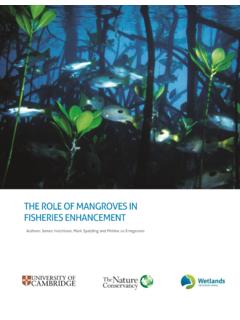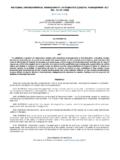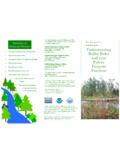Transcription of symposium - Mangrove restoration
1 symposium ZOOLOGICAL SOCIETY OF LONDON REGENTS PARK, LONDON, NW1 4RY 6 and 7 November 2014 TURNING THE TIDE ON Mangrove LOSS ABSTRACTS Organised by Louise Baldwin, Zoological Society of London; Heather Koldewey, Zoological Society of London; Jurgenne Primavera, Zoological Society of London & Co-chair of the IUCN SSC Mangrove Specialist Group; Joe Lee, Griffith University & Co-chair of the IUCN SSC Mangrove Specialist Group Photos: ZSL REGISTRATION OPENS Welcome Keynote: Mangrove conservation in a Chinese megalopolis Brian Morton OBE DSc FZS, The University of Hong Kong, China Email: The focus of the southern Chinese province of Guangdong is the Pearl River draining a vast area (~453,700 km2) of China.
2 The river is >100 km wide at its mouth, with Macau and Hong Kong flanking western and eastern banks, respectively. The Pearl is the second largest river in China, with an estimated flow of ~10,000 m3 second. Guangdong s population of >110 million is of China's total. Its capital, Guangzhou, is the third largest Chinese city. The modern Guangdong city of Shenzhen has become the 10th most populous city and is China s economic powerhouse. The population of the Pearl River Delta Economic Zone, the world s first Mega City, or megalopolis, has an urban population of >150 million. This does not, however, include Macau and Hong Kong, with resident populations of and million, respectively, but with transient populations of >130 million. With a land area of only 1,104 km2, the Alpha+ City of Hong Kong has, in Kowloon, a population density of ~44,000 km-2, making it the most dense human conurbation ever known.
3 The Pearl s delta is, therefore, home to >160 million people, but regional goals for 2020 include three new cities, the expansion of road, rail, seaport and airport infrastructures and the construction of the 50 km long Hong Kong Zhuhai Macau Bridge across the Pearl. Since the end of the last ice age, sea levels have risen in southern China by >10 metres and, because of the vast amounts of silt deposited by the river (~86 million tonnes each year), the Pearl s estuarine flanks are, or were, bordered everywhere by mangroves these here close to the northern limits of the species ranges and representing the most populous and diverse community within China. These tall plants, in stabilising the river s banks, accumulate up to 5 cm of silt annually, protecting shorelines from typhoons but also facilitating natural coastal reclamation.
4 Only two areas of such mangroves are protected in the Pearl s estuary: Mai Po in Hong Kong and opposite it, at Shenzhen, in China. The eastern, Mirs Bay, waters of Hong Kong, away from the Pearl, however, support another Mangrove community of conspecific species but of bonsai proportions. Mountain streams draining into the bay are part of Hong Kong s East and West Sai Kung Country Parks and home to two marine parks at Li Chi Wo and Hoi Ha. Hitherto protected by sparse, village-based, communities, these eastern mangroves are now too under development threats. Keynote: Understanding and quantifying the many values of mangroves, globally and locally Mark Spalding, The Nature Conservancy & University of Cambridge, UK Email: Mangroves are Olympians in terms of their ecosystem services values, leading the field in terms of their importance for carbon storage and sequestration, for fisheries enhancement, and for coastal protection services.
5 Mangroves are also among the best protected of all ecosystems, with 36% now within protected areas. But this is not enough mangroves are still being TURNING THE TIDE ON Mangrove LOSS 6 NOVEMBER 2014 degraded and lost, and these losses are coming along with impacts on coastal communities world-wide. To change attitudes and move the needle we need to greatly improve understanding of the value of mangroves. This requires more targeted science and better communications. Global summary values have raised attention, but often lack the substance to back up the sweeping claims. Following a simple approach of review-model-map a new initiative is pulling together information from disparate sources to understand, then to model and ideally to map critical ecosystem services at different scales.
6 New global maps of carbon storage and the nearshore fisheries value of mangroves highlight the considerable spatial variability in Mangrove values. Such maps may be more compelling to decision-makers than previous global averages which lacked much in the way of practical utility. At different scales improved understanding and models of the role of mangroves in coastal protection are already helping in the development and use of mangroves in coastal engineering. Accurate and reliable valuation of mangroves has the potential to open new doors in terms of conservation, wise management and restoration . POSTER SESSION (TEA/COFFEE) SESSION I: HOW MANY MANGROVES ARE THERE AND WHERE ARE THEY? _____ Exploring Mangrove diversity with technical innovations for science and community partnerships Norm C Duke, James Cook University, Australia Email: Who amongst us has funding support to collect and collate information on Mangrove plants?
7 However, we all know such studies are fundamental to turning the tide on their loss. And, there are further stumbling blocks holding up progress. The world list remains undecided, even the definition of a Mangrove itself. As well, new Mangrove plants are still being described. These problems of definition are coupled with unprecedented threats from climate change and growing human pressures. However, we have the perfect study tool for at least collating information on plants. Smart new electronic gadgets can capture geo-referenced data and digital images. Shouldn t we be making greater use of such tools? These popular mobile devices present cogent opportunities in offering solutions to the pressing challenges in protecting mangroves. These devices can fundamentally assist our collation of information.
8 But, importantly also, they provide the means to harness a wider group of volunteer observers. This will greatly expand the knowledge base for embattled Mangrove habitat worldwide. SESSION II: LIFE WITHIN THE MANGROVES: LIVELY OR LIFELESS? _____ Ecological and evolutionary significance of invertebrate behaviour for Mangrove ecosystems Stefano Cannicci, University of Florence, Italy Email: Mangrove forests cover a considerable part of the world s tropical and subtropical coasts. They are among the most productive ecosystems, providing substantial goods and services for local populations and the entire planet. The last 20 years have witnessed a real paradigm shift concerning the impact of biotic factors on their ecosystem functions.
9 Prior to this kind of scientific revolution, structural and functional aspects of mangroves were viewed as the result of abiotic processes acting from the bottom up. A number of recent studies, however, leave no doubt about the paramount role of behavioural traits of the Mangrove macrofauna in the functioning of such forests. Feeding behaviour, digging activity, and terrestrial adaptations of crabs strongly influence the C and N cycles and their fluxes in Mangrove forests as well as their carbon-stock potential. Recent data also show that the physiological and behavioural adaptations of crabs to terrestrial life have in fact a major impact on the oxygen flux and dynamics of the soil, ultimately contributing to the overall outstanding, and puzzling, primary productivity of these forests.
10 These forests are nevertheless also considered amongst the most vulnerable and endangered ecosystems in the world, with no information available on the vulnerability of keystone macrofauna to climate change. Mangrove trees are definitely threatened by sea-level rise and by human land reclamation, but the global exposure of these systems to other factors related to climate change, such as temperature rise and ocean acidification, is still a challenging dilemma. I demonstrate how a mechanistic approach, involving the integration of data from behavioural and physiological traits of keystone invertebrates, conveniently integrated with environmental data, can resolve the above scientific challenge and help draw realistic scenarios of Mangrove vulnerability to climate change.







